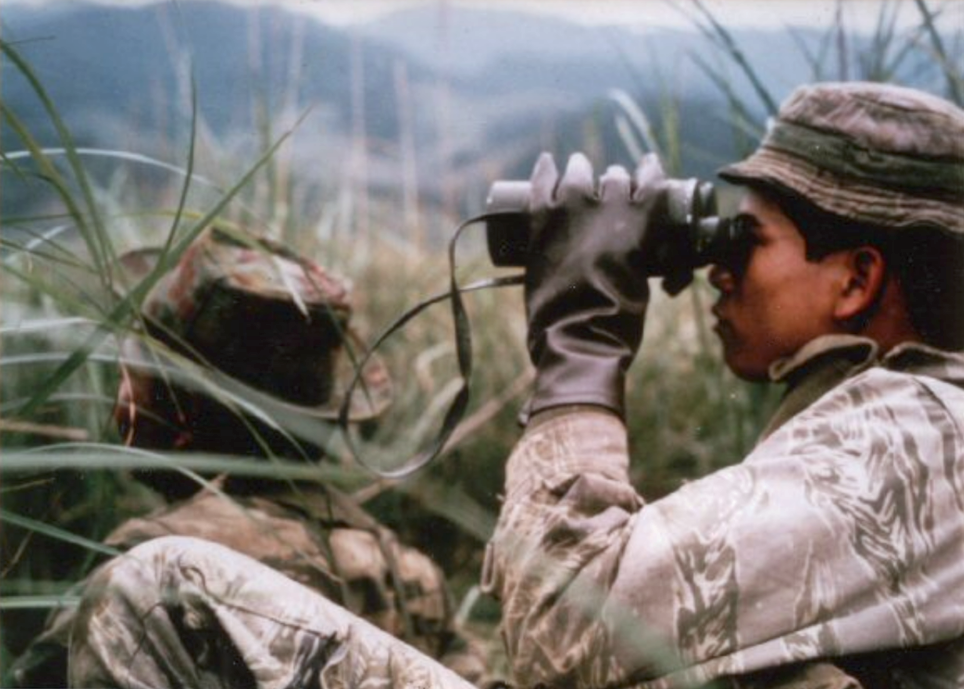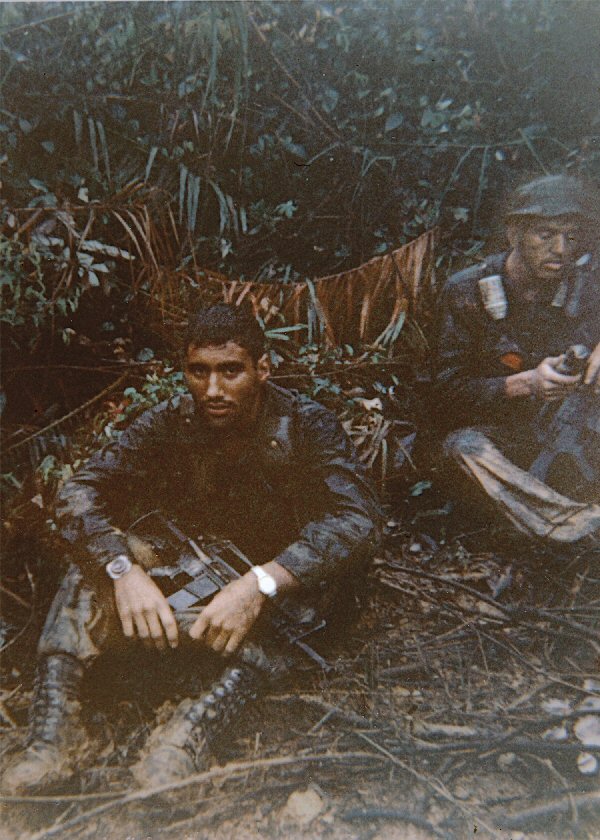|
Battle Of Signal Hill (Vietnam)
The Battle of Signal Hill was a company size engagement between members of Company E, 52nd Infantry (LRP) long-range reconnaissance patrol of the 1st Cavalry Division (Airmobile) and the People's Army of Vietnam (PAVN) from 19–21 April 1968 during Operation Delaware. Signal Hill was the name given to the peak of Dong Re Lao Mountain, a densely forested mountain in the A Sầu Valley. The strategic location made it an ideal communication and fire support site, vital to the success of Operation Delaware. Background The PAVN gained control of the A Sầu Valley in March 1966 after overrunning the last Special Forces camp in the area. They then fortified the valley with powerful crew-served 37mm antiaircraft cannons, some of them radar controlled. They also emplaced rapid firing twin-barreled 23mm cannons and many 12.7mm heavy machine guns to contribute to their air defenses. The A Sầu Valley soon evolved into a major logistics depot for the PAVN, with storage locations ... [...More Info...] [...Related Items...] OR: [Wikipedia] [Google] [Baidu] |
Company E, 52nd Infantry (LRP)
Company E, 52nd Infantry, (LRP) was a 120 man-sized long-range reconnaissance patrol unit attached to the 1st Cavalry Division (Airmobile) in Vietnam in 1967-69. Its origin begins on January 1, 1967, as "LRRP Detachment G2," 1st Cavalry Division (Airmobile). It was then redesignated "Headquarters & Headquarters Company LRRP Detachment" in April 1967, and redesignated "Company E, 52nd Infantry (LRP)" on December 20, 1967.Ankony, Robert C., ''Lurps: A Ranger's Diary of Tet, Khe Sanh, A Shau, and Quang Tri,'' revised ed., Rowman & Littlefield Publishing Group, Lanham, MD (2009)/ref> Later, when all LRRP units were folded into the US Army Rangers on February 1, 1969, Company E was redesignated, "H Company, 75th Infantry (Ranger). History In November 1966 Captain James D. James, a Special Forces-trained officer, and Ranger Staff Sergeant Ronald Christopher, were selected to establish a long-range reconnaissance patrol detachment for the 1st Cavalry Division, designated "LRRP Detachmen ... [...More Info...] [...Related Items...] OR: [Wikipedia] [Google] [Baidu] |
Central Highlands (Vietnam)
Central Highlands ( vi, Cao nguyên Trung phần), Western Highlands ( vi, Tây Nguyên) or Midland Highlands ( vi, Cao nguyên Trung bộ) is one of the regions of Vietnam. It contains the provinces of Đắk Lắk, Đắk Nông, Gia Lai, Kon Tum, and Lâm Đồng. Provinces History The native inhabitants of the Central Highlands (Montagnards, Mountain peoples) are various peoples that mainly belonged to the two major Austronesian (Highland Chamic) and Austroasiatic ( Bahnaric) ethnolinguistic families. According to Peng et al. (2010) & Liu et al. (2020), Austronesian Chamic groups were well known of being seafarers with the original homeland of Taiwan, might have migrated to present-day Central Vietnam by sea from Maritime Southeast Asia around ~ 2,500 kya, while were making contact/or possibly absorbed the previously earlier Austroasiatic inhabitants (research shows shared high frequencies of AA-associated ancestry among Vietnam's Austronesian Chamic highlanders than ... [...More Info...] [...Related Items...] OR: [Wikipedia] [Google] [Baidu] |
Volume Expander
A volume expander is a type of intravenous therapy that has the function of providing volume for the circulatory system. It may be used for fluid replacement or during surgery to prevent nausea and vomiting after surgery. Physiology When blood is lost, the greatest immediate need is to stop further blood loss. The second greatest need is replacing the lost volume. This way remaining red blood cells can still oxygenate body tissue. Normal human blood has a significant excess oxygen transport capability, only used in cases of great physical exertion. Provided blood volume is maintained by volume expanders, a rested patient can safely tolerate very low hemoglobin levels, less than 1/3 that of a healthy person. The body detects the lower hemoglobin level, and compensatory mechanisms start up. The heart pumps more blood with each beat. Since the lost blood was replaced with a suitable fluid, the now diluted blood flows more easily, even in the small vessels. As a result of chemical ch ... [...More Info...] [...Related Items...] OR: [Wikipedia] [Google] [Baidu] |
McGuire Rig
The McGuire Rig was used to extract soldiers from the jungles of Vietnam. It would be suspended from a helicopter and used to extract soldiers from areas without a suitable pick-up zone. It was simple, inexpensive, and effective. Although less comfortable than the STABO (Short Tactical Air Borne Operations) harness, it did not require the soldiers to carry any special equipment. It was designed by Sergeant Major Charles T. McGuire, a member of Project DELTA, a Special Forces reconnaissance project. The McGuire Rig was fashioned from a wide, long A7A nylon cargo tie-down strap with a quick-fit buckle on one end. This was typically cut down to an length and a web loop (wrist strap) attached near the top end. This was used to form a sling loop and attached to an over length of 5/8-inch nylon rope. Three ropes with McGuire Rigs attached could be dropped from a UH-1 "Huey" helicopter, all on the same side. A deployment pack containing a sandbag carried each rope to the ground. T ... [...More Info...] [...Related Items...] OR: [Wikipedia] [Google] [Baidu] |
Bangalore Torpedo
A Bangalore torpedo is an explosive charge placed within one or several connected tubes. It is used by combat engineers to clear obstacles that would otherwise require them to approach directly, possibly under fire. It is sometimes colloquially referred to as a "Bangalore mine", "banger" or simply "Bangalore" as well as a pole charge. Per United States Army Field Manual 5-250 section 1-14, page 1-12 "b. Use. The primary use of the torpedo is clearing paths through wire obstacles and heavy undergrowth. It will clear a 3- to 4-metre wide path through wire obstacles." Overview The Bangalore torpedo was devised by Captain R. L. McClintock of the Royal Engineers while attached to the Madras Sappers and Miners unit of the Indian Army at Bangalore, India, in 1912. He invented it as a means of blowing up booby traps and barricades left over from the Second Boer War and the Russo-Japanese War. The Bangalore torpedo could be exploded over a mine without a sapper having to approach ... [...More Info...] [...Related Items...] OR: [Wikipedia] [Google] [Baidu] |
1st Battalion, 227th Aviation Regiment (United States)
The 1st Battalion, 227th Aviation Regiment is an attack helicopter battalion of the Combat Aviation Brigade, 1st Cavalry Division. The battalion is an AH-64 Apache battalion based at Fort Hood, Texas. History The unit's nickname is "First Attack" because 1st Cavalry Division was "First into Manila" in February 1945. Major General William C. Chase gave the Division its nickname "First Team", it was well-received and remains today. In September 1945, the "First Team" led occupational forces in to Japan's capital city, earning the distinction of "First in Tokyo". Next, the 1st Cavalry Division stormed ashore at Poe-Hongdong, South Korea, in the Korean War's first amphibious landing. By July 1950, the Division began offensive operations to the north and crossed the 38th parallel on 9 October 1950. Closing on North Korea's capital 10 days later, the "First Team" was "First in Pyongyang". In July 1965, the 1st Cavalry Division was re-stationed to Fort Benning, Georgia and organized for ... [...More Info...] [...Related Items...] OR: [Wikipedia] [Google] [Baidu] |
Bell UH-1 Iroquois
The Bell UH-1 Iroquois (nicknamed "Huey") is a utility military helicopter designed and produced by the American aerospace company Bell Helicopter. It is the first member of the prolific Huey family, as well as the first turbine-powered helicopter in service with the United States military. Development of the Iroquois started in the early 1950s, a major impetus being a requirement issued by the United States Army for a new medical evacuation and utility helicopter. The Bell 204, first flown on 20 October 1956, was warmly received, particularly for the performance of its single turboshaft engine over piston engine-powered counterparts. An initial production contract for 100 ''HU-1A''s was issued in March 1960. In response to criticisms over the rotorcraft's power, Bell quickly developed multiple models furnished with more powerful engines; in comparison to the prototype's Lycoming YT53-L-1 (LTC1B-1) engine, producing 700 shp (520 kW), by 1966, the Lycoming T53-L-13, ... [...More Info...] [...Related Items...] OR: [Wikipedia] [Google] [Baidu] |
LRRP
A long-range reconnaissance patrol, or LRRP (pronounced "lurp"), is a small, well-armed reconnaissance team that patrols deep in enemy-held territory.Ankony, Robert C., ''Lurps: A Ranger's Diary of Tet, Khe Sanh, A Shau, and Quang Tri,'' revised ed., Rowman & Littlefield Publishing Group, Lanham, MD (2009)/ref> The concept of scouts dates back to the origins of warfare itself. However, in modern times these specialized units evolved from examples such as Rogers' Rangers in colonial British America, the Lovat Scouts in World War One, the Long Range Desert Group and the Special Air Service in the Western Desert Campaign and North West Europe, similar units such as Force 136 in East Asia, and the special Finnish light infantry units during the Second World War. Postwar, the role was carried in various North Atlantic Treaty Organization (NATO) and British Commonwealth countries by units that could trace their origins to these wartime creations such as the British SAS, Australia's ... [...More Info...] [...Related Items...] OR: [Wikipedia] [Google] [Baidu] |
First Crashed Helicopter
First or 1st is the ordinal form of the number one (#1). First or 1st may also refer to: *World record, specifically the first instance of a particular achievement Arts and media Music * 1$T, American rapper, singer-songwriter, DJ, and record producer Albums * ''1st'' (album), a 1983 album by Streets * ''1st'' (Rasmus EP), a 1995 EP by The Rasmus, frequently identified as a single * '' 1ST'', a 2021 album by SixTones * ''First'' (Baroness EP), an EP by Baroness * ''First'' (Ferlyn G EP), an EP by Ferlyn G * ''First'' (David Gates album), an album by David Gates * ''First'' (O'Bryan album), an album by O'Bryan * ''First'' (Raymond Lam album), an album by Raymond Lam * ''First'', an album by Denise Ho Songs * "First" (Cold War Kids song), a song by Cold War Kids * "First" (Lindsay Lohan song), a song by Lindsay Lohan * "First", a song by Everglow from ''Last Melody'' * "First", a song by Lauren Daigle * "First", a song by Niki & Gabi * "First", a song by Jonas Brot ... [...More Info...] [...Related Items...] OR: [Wikipedia] [Google] [Baidu] |
Camp Evans (Vietnam)
Camp Evans is a former U.S. Army and U.S. Marine Corps base northwest of Huế in central Vietnam. History 1966-7 Camp Evans was established by the 3rd Battalion, 26th Marines in late 1966 as part of Operation Chinook. The camp was located to the west of Highway 1, approximately 24 km northwest of Huế in Thừa Thiên–Huế Province. The camp was named after Marine Lance Corporal Paul Evans who was killed during Operation Chinook. Marine units based at Camp Evans during this period included: *4th Marine Regiment 1968 In January 1968 Camp Evans was taken over by the 1st Cavalry Division. On the night of 19 May 1968 the ammunition dump at Camp Evans was hit by People's Army of Vietnam (PAVN) rockets and exploded causing a chain reaction and fire that lasted more than 12 hours and damaged or destroyed 124 aircraft rendering the 1st Brigade, 1st Cavalry Division combat ineffective for a week until replacement aircraft arrived. On 3 October 1968 a USAF C-7 Caribo ... [...More Info...] [...Related Items...] OR: [Wikipedia] [Google] [Baidu] |





